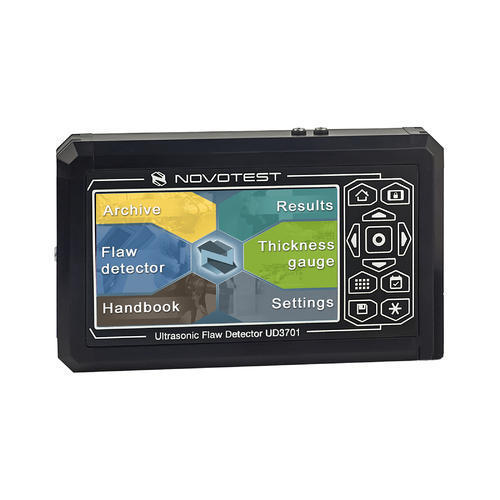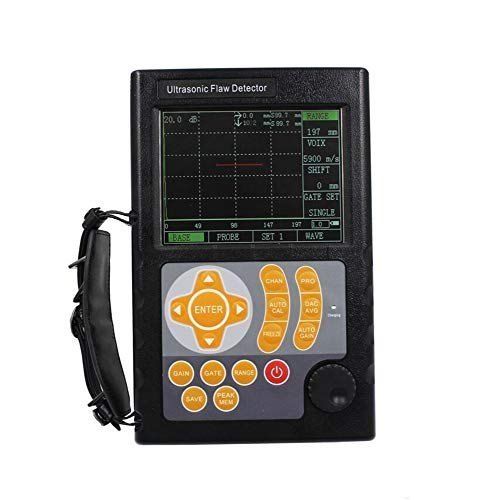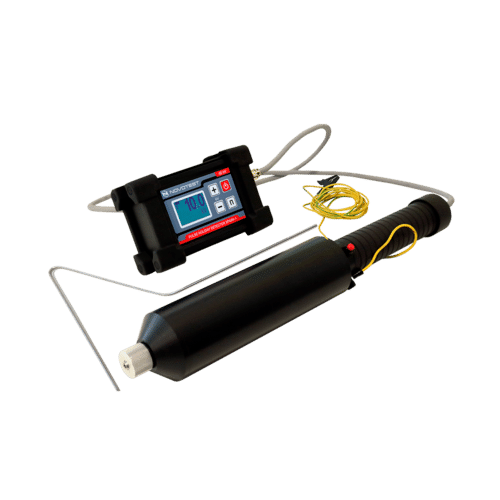Digital Ultrasonic Flaw Detector
115000 INR/Unit
Product Details:
- Product Type Ultrasonic Flaw Detector
- Weight 1 Kilograms (kg)
- Usage Industrial
- Color Black
- Dimension (L*W*H) 50x160x238 Millimeter (mm)
- Power 9 Volt (v)
- Frequency 0.2 to 20 Megahertz (MHZ)
- Click to View more
X
Digital Ultrasonic Flaw Detector Price And Quantity
- 115000 INR/Unit
- 1 Unit
Digital Ultrasonic Flaw Detector Product Specifications
- 0.2 to 20 Megahertz (MHZ)
- 50x160x238 Millimeter (mm)
- Industrial
- 9 Volt (v)
- Ultrasonic Flaw Detector
- 1 Kilograms (kg)
- Black
Digital Ultrasonic Flaw Detector Trade Information
- 1000 Unit Per Day
- 1 Week
Product Description
A digital ultrasonic flaw detector is a non-destructive testing (NDT) device used to locate and size flaws in materials, such as cracks, voids, and inclusions. It works by sending ultrasonic sound waves into the material and measuring the time it takes for the waves to reflect back. The reflected waves, or echoes, are then analyzed to determine the size and location of any flaws.
Advantages:
- Automated calibration (IIW), Automated gain
- DAC, AVG, TCG, B scan, AWS, No Limited Video record,
- High-speed capture and very low noise
- high contrast viewing of the waveform from bright
- Powerful pc software and reports can be export to excel
- Automated calibration of transducer Zero Offset and/or Velocity
- Automated gain, Peak Hold and Peak Memory
- Automated display precise flaw location (Depth d, level p, distance s, amplitude, sz dB)
- Automated switch three staff gauge (Depth d, level p, distance s)
- 100 independence setup, any criterion can be input freely, we can work in the scene without test block
- Big memory of 500 A graph
- Gate and DAC alarm, Acoustic-Optical alarm
- USB port, communication with pc is easy
- The embed software can be online updated
- Li battery, continue working time up to 10 hours
- Display freeze
- Automated echo degree
- Angles and K-value
- Lock and unlock function of system parameters
- AWS D1.1
- Dormancy and screen savers
- Electronic clock calendar
- There are 14 standards of DAC in UTS-260
- Automated make video of test process and play Connect the USB Disk, the length of video is unlimited
- Two gates setting and alarm indication
- High-speed capture and very low noise
- DAC, AVG, TCG, B Scan, Solid plastic housing (IP65)
- Automated calculate the size of the flaw with w ide bottom type in AVG function
- 6dB DAC functions
- Provides high contrast viewing of the waveform from bright, direct sunlight to complete darkness and easy to read from all angles
- Powerful pc software and reports can be export to excel
- Technical Parameters
- Range of scanning (mm) Range of scanning (mm): 0-6000
- Steps: 2.5, 5, 10, 20, 30, 40, 50, 60, 70, 80, 90, 100, 150, 200, 250, 300, 350, 400, 450, 500, 600, 700, 800, 900, 1000, 2000, 3000, 4000, 5000, 6000, 7000, 8000, 9000,10000
- Adjusting step: 0.1 mm(2.5 mm-99.9 mm), 1 mm(100 mm-10000 mm)
- D-delay (s) D-delay (s): -20-+3400
- Steps: -20, -10, 0.0, 10, 20, 50, 100, 150, 200, 250, 300, 350, 400, 450, 500, 600, 700, 800, 900, 1000, 1500, 2000, 2500, 3000, 3400
- Adjusting steps: 0.1(-20 s-999.9 s), 1(1000 s-3400 s)
Digital Ultrasonic Flaw Detector Specifications:
1. Model Name/Number: PRO-UR-UT-UTS-260
2. Weight: 1.0 Kg
3. Frequency: 0.2 to 20 MHz
4. Display Type: 0 to130 DB
5. Temperature: 20-50 degree centigrade
6. Power: 1.5A 9V
7. Dimension: 50x160x238 mm
Here's how it works:
1. Transducer: An ultrasonic transducer is placed on the surface of the material being inspected. The transducer converts electrical energy into ultrasonic sound waves, which are then transmitted into the material.
2. Sound waves: The sound waves travel through the material until they encounter a flaw or boundary. When they encounter a flaw, some of the sound waves are reflected back towards the transducer.
3. Receiver: The reflected sound waves are received by the transducer and converted back into electrical energy.
4. Display: The electrical signals are then processed and displayed on the flaw detector's screen. The display typically shows a waveform, which is a graph of the amplitude of the received signal versus time.
5. Analysis: The operator can then analyze the waveform to determine the size and location of any flaws.
Digital ultrasonic flaw detectors offer several advantages over traditional analog flaw detectors, such as:
1. Increased accuracy: Digital flaw detectors can more accurately measure the size and location of flaws.
2. Improved data storage and retrieval: Digital flaw detectors can store and retrieve data electronically, which makes it easier to track and analyze inspection results.
3. More features: Digital flaw detectors offer a wider range of features, such as color displays, multiple transducer inputs, and data logging capabilities.
Digital ultrasonic flaw detectors are used in a wide variety of industries, including:
1. Aerospace: To inspect aircraft components for cracks and other flaws.
2. Automotive: To inspect welds, castings, and other components for flaws.
3. Chemical processing: To inspect pipes, vessels, and other equipment for corrosion and other damage.
4. Power generation: To inspect turbines, boilers, and other equipment for damage.
5. Welding: To inspect welds for cracks, porosity, and other flaws.
Digital Ultrasonic Flaw Detector FAQ:
Q. What is a digital ultrasonic flaw detector?
Ans: A digital ultrasonic flaw detector is a portable electronic device used in non-destructive testing (NDT) to detect and characterize defects or discontinuities in materials, primarily metals and alloys, using ultrasonic waves.
Q. How does a digital ultrasonic flaw detector work?
Ans: It works by generating high-frequency ultrasonic waves which are directed into the material being tested. These waves travel through the material until they encounter a boundary or defect, where they are reflected back to the instrument. By analyzing the time taken for the waves to return and their amplitude, the detector can determine the size, shape, and location of any flaws.
Q. What are the advantages of digital ultrasonic flaw detectors over traditional analog models?
Ans: Digital ultrasonic flaw detectors offer superior signal processing capabilities, allowing for clearer and more accurate flaw detection. They often have advanced features such as data logging, waveform storage, and automated analysis algorithms, enhancing efficiency and reliability in testing processes.
Q. What types of flaws can be detected with a digital ultrasonic flaw detector?
Ans: Common flaws detected include cracks, voids, inclusions, lack of fusion, and other discontinuities in materials. These detectors are used across various industries such as manufacturing, aerospace, automotive, and construction for quality control and safety assessment.
Q. What are some key features to look for in a digital ultrasonic flaw detector?
Ans: Important features include:
1. Frequency range: Higher frequencies provide better resolution for detecting smaller flaws, while lower frequencies penetrate deeper into materials.
2. Display resolution and size: A clear, high-resolution display is essential for accurate flaw interpretation.
3. Data recording and analysis capabilities: This includes options for storing waveforms, generating reports, and performing automated analysis.
4. Battery life and portability: Longer battery life and lightweight design improve usability in field environments.
5. Connectivity options: USB, Bluetooth, or Wi-Fi connectivity for data transfer and integration with other devices or software.
Q. What are the typical applications of digital ultrasonic flaw detectors?
Ans: These detectors are used in a wide range of applications, including weld inspection, corrosion assessment, thickness measurement, and material characterization in industries such as manufacturing, oil and gas, power generation, and infrastructure maintenance.
Q. How important is training for operating a digital ultrasonic flaw detector?
Ans: Proper training and certification are crucial for effective and safe operation of digital ultrasonic flaw detectors. Users need to understand the principles of ultrasonic testing, instrument setup, calibration procedures, and interpretation of test results to ensure reliable inspection outcomes.
Q. Can digital ultrasonic flaw detectors be used for underwater inspections?
Ans: Yes, there are specialized digital ultrasonic flaw detectors designed for underwater use, equipped with waterproof housings and transducers suitable for submersion. These are commonly used in marine, offshore, and underwater construction applications.
Q. What are the limitations of digital ultrasonic flaw detectors?
Ans: Limitations include the inability to detect flaws perpendicular to the ultrasonic beam, the need for skilled operators, surface preparation requirements, and restrictions related to material thickness and geometry. Additionally, certain materials with coarse grain structures or high attenuation may pose challenges for flaw detection.
Q. Are digital ultrasonic flaw detectors suitable for use in hazardous environments?
Ans: Some models are designed to meet safety standards for use in hazardous environments, with features such as intrinsically safe certifications and ruggedized enclosures to withstand harsh conditions. However, users should always adhere to safety protocols and regulations applicable to their specific work environments.
Enter Buying Requirement Details
 English
English Spanish
Spanish French
French German
German Italian
Italian Chinese (Simplified)
Chinese (Simplified) Japanese
Japanese Korean
Korean Arabic
Arabic Portuguese
Portuguese





 Call Me Free
Call Me Free